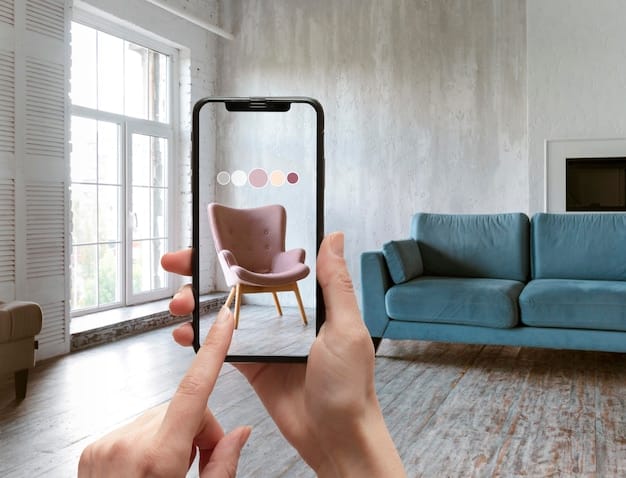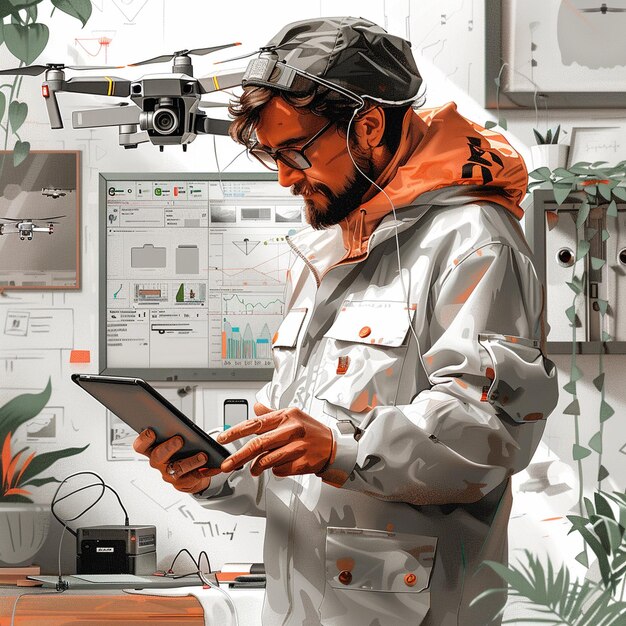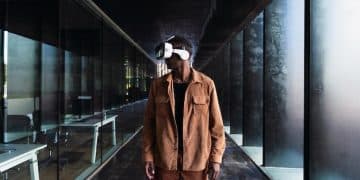Augmented Reality in Business: Practical Applications and Benefits

Augmented Reality (AR) offers numerous practical applications in business, enhancing customer experiences, improving operational efficiency, and creating innovative marketing strategies by overlaying digital information onto the real world.
Dive into the world of Augmented Reality: What Are the Practical Applications for AR in Business? Discover how this technology is transforming industries and creating new opportunities for growth and innovation.
Understanding Augmented Reality and Its Potential
Augmented Reality (AR) is more than just a futuristic concept; it’s a tangible technology that’s reshaping how businesses operate and interact with customers. By blending digital elements with the real world, AR offers immersive experiences that can enhance various aspects of business operations.
From improving training programs to revolutionizing marketing campaigns, AR’s potential is vast and varied. Let’s explore the fundamental aspects of AR and its transformative capabilities.
What is Augmented Reality?
Augmented Reality is a technology that overlays computer-generated images onto a user’s view of the real world, providing a composite view. Unlike Virtual Reality (VR), which creates a completely virtual environment, AR enhances the existing reality with digital additions.
How AR Works
AR systems typically use cameras and sensors to detect the real-world environment and overlay digital content onto it. This can be achieved through smartphones, tablets, or specialized AR glasses. The software recognizes specific markers or locations and then displays relevant digital information, creating an interactive and engaging experience.

Here are some key components of AR technology:
- Hardware: Devices like smartphones, tablets, and AR headsets equipped with cameras and sensors.
- Software: Apps and platforms that interpret the real-world environment and generate digital overlays.
- Tracking: Technologies that enable the AR system to accurately map and understand the user’s surroundings.
AR’s ability to provide real-time, contextual information makes it a valuable tool for businesses looking to improve efficiency, enhance customer engagement, and differentiate themselves in the market.
Enhancing Customer Experience with AR
One of the most significant impacts of AR is its ability to transform customer experiences. By providing interactive and engaging ways for customers to interact with products and services, AR can drive sales, increase brand loyalty, and create memorable experiences.
AR applications in customer experience are diverse and innovative, catering to a wide range of industries and business needs.
AR in Retail
In the retail sector, AR allows customers to virtually try on clothes, visualize furniture in their homes, and preview products before making a purchase. This can significantly reduce the uncertainty associated with online shopping and increase customer confidence.
Interactive Product Demos
AR can also be used to create interactive product demonstrations that allow customers to explore product features and benefits in a more engaging way. For example, a car manufacturer could use AR to let customers customize a vehicle and see it in their driveway before visiting a dealership.
Examples of AR enhancing customer experience include:
- Virtual Try-On: Apps that use AR to let customers see how makeup, glasses, or clothing would look on them.
- Home Visualization: Tools that allow customers to place virtual furniture or decor items in their homes to see how they fit.
- Interactive Catalogs: Catalogs that come to life with AR, providing additional product information and interactive experiences when viewed through a smartphone or tablet.
By leveraging AR, businesses can create more personalized and immersive shopping experiences that drive sales and build stronger customer relationships.
Improving Training and Education
AR is revolutionizing training and education by providing immersive and interactive learning experiences. Whether it’s training employees on complex machinery or educating students in a classroom setting, AR can make learning more engaging and effective.
The benefits of using AR in training and education are numerous, ranging from improved retention rates to reduced training costs.
Hands-On Training Simulations
AR allows for the creation of realistic training simulations that enable employees to practice complex tasks in a safe and controlled environment. This is particularly valuable in industries such as healthcare, manufacturing, and aerospace, where mistakes can be costly or dangerous.
Interactive Educational Tools
In the classroom, AR can bring textbooks and lessons to life, making learning more interactive and engaging for students. From exploring the human body in 3D to visualizing historical events, AR can enhance understanding and retention.

Here are some specific applications of AR in training and education:
- Medical Training: AR apps that allow medical students to explore the human anatomy in detail and practice surgical procedures.
- Equipment Maintenance: AR tools that guide technicians through the steps of repairing complex equipment using visual overlays.
- Historical Reconstructions: AR experiences that transport students back in time to explore historical sites and events.
By offering immersive and interactive learning experiences, AR is transforming the way we train and educate individuals, making learning more effective and accessible.
Streamlining Operations and Maintenance
AR is not just for customer-facing applications; it also offers significant benefits for internal operations and maintenance. By providing real-time information and guidance, AR can streamline processes, reduce errors, and improve efficiency.
From remote assistance to predictive maintenance, AR is transforming the way businesses manage their operations and assets.
Remote Assistance
AR enables remote experts to provide real-time assistance to field technicians, guiding them through complex repairs and maintenance tasks. This can significantly reduce downtime and minimize the need for on-site visits.
Predictive Maintenance
AR can be used to overlay sensor data onto equipment, allowing technicians to identify potential issues before they lead to breakdowns. This enables proactive maintenance, reducing the risk of costly downtime and extending the lifespan of assets.
Specific applications of AR in streamlining operations and maintenance include:
- Equipment Repair: AR apps that provide step-by-step instructions for repairing machinery using visual overlays.
- Inventory Management: AR tools that help warehouse workers locate and track inventory items more efficiently.
- Quality Control: AR systems that overlay quality control checklists onto products, ensuring that all standards are met.
By providing real-time information and guidance, AR is helping businesses optimize their operations, reduce costs, and improve overall efficiency.
Revolutionizing Marketing and Advertising
AR is revolutionizing marketing and advertising by offering immersive and interactive experiences that capture attention and engage customers. From virtual product demos to interactive ads, AR is helping businesses create memorable marketing campaigns that drive results.
The key to successful AR marketing is to provide value to the customer while showcasing products and services in an innovative and engaging way.
Interactive Advertisements
AR-enabled advertisements allow customers to interact with products and services in a virtual environment. For example, a furniture retailer could create an AR ad that allows customers to place a virtual sofa in their living room to see how it looks.
Virtual Product Demos
AR can also be used to create virtual product demos that allow customers to explore product features and benefits in an interactive way. This is particularly effective for products that are difficult to demonstrate in a traditional advertisement.
Examples of AR marketing and advertising campaigns include:
- Virtual Try-On Ads: Cosmetic brands using AR to let customers virtually try on makeup through their smartphone cameras.
- Interactive Print Ads: Print ads that come to life with AR, providing additional information and interactive experiences when viewed through a smartphone or tablet.
- AR Games: Brands creating AR games that promote their products or services in a fun and engaging way.
By offering immersive and interactive experiences, AR is helping businesses cut through the noise and create marketing campaigns that truly resonate with customers.
Challenges and Future Trends in Augmented Reality
While AR offers tremendous potential, it also faces certain challenges. Addressing these challenges and staying abreast of future trends will be crucial for businesses looking to leverage AR effectively.
From technological limitations to user adoption, understanding these factors will help businesses make informed decisions about their AR investments.
Technological Limitations
Current AR technology still has limitations, such as processing power, battery life, and display quality. Overcoming these limitations will be essential for widespread adoption.
User Adoption
Convincing consumers to embrace AR technology and integrate it into their daily lives is another challenge. Creating compelling and useful AR experiences will be key to driving adoption.
Future trends in Augmented Reality worth noting:
- Improved Hardware: Advances in AR glasses and headsets will make AR technology more accessible and convenient.
- Enhanced Software: AI and machine learning will enhance AR software, making it more accurate and responsive.
- Wider Adoption: As technology improves and costs decrease, AR will become more prevalent in various industries and applications.
By addressing these challenges and staying informed about future trends, businesses can unlock the full potential of AR and gain a competitive edge in the market.
| Key Point | Brief Description |
|---|---|
| 🛍️ Enhanced Customer Experience | AR transforms shopping with virtual try-ons and interactive product demos. |
| 🧑🏫 Improved Training | AR offers hands-on training simulations to improve learning outcomes. |
| ⚙️ Streamlined Operations | AR aids in remote assistance and predictive maintenance for efficient operations. |
| 📢 Revolutionized Marketing | AR creates engaging marketing with interactive ads and virtual product demos. |
Frequently Asked Questions About Augmented Reality in Business
▼
Augmented Reality (AR) enhances the real world with digital overlays, while Virtual Reality (VR) creates a fully immersive digital environment, replacing the real world entirely.
▼
AR provides interactive product demos and virtual try-ons, allowing customers to engage with products in an innovative and personalized way, thereby increasing engagement.
▼
Retail, healthcare, manufacturing, and education are among the industries that benefit most from AR applications due to enhanced training, streamlined operations, and improved customer experiences.
▼
Challenges include technological limitations such as processing power and battery life, as well as ensuring user adoption through compelling and useful AR experiences.
▼
Future trends include improved hardware like AR glasses, enhanced software powered by AI, and wider adoption across various industries as technology becomes more accessible and affordable.
Conclusion
In conclusion, Augmented Reality: What Are the Practical Applications for AR in Business? is not just a futuristic concept but a present-day reality that offers businesses numerous opportunities to enhance customer experiences, improve operational efficiency, and create innovative marketing strategies. By understanding its potential and addressing its challenges, businesses can leverage AR to gain a competitive edge and drive growth in an increasingly digital world.





